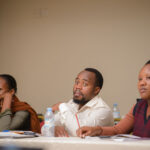This article was published more than 3 years ago.
Nearly two years since the world as we knew it was turned upside down by COVID-19, the Fund is coming to terms with an amazing amount of change.
We have had our assumptions about everything from the future of democracy to the nature of work environments upended. We have also—as an organization and as individuals—dealt with significant challenges in the past two years. We have juggled family responsibilities while chairing meetings from kitchen tables. New staff members have worked for months without ever meeting colleagues in person. We have worked hard to address our deficits. And we have celebrated all that makes this community remarkable.
Now, as a new year dawns, we’re ready to keep moving forward.
The Moment We’re In
Throughout 2021, the Fund asked itself some big questions. What are our priorities? What do we need to do to meet those challenges and seize those opportunities? How do we want the organization to evolve?
The world feels very much in flux: Where do we go from here?
This inquiry—with colleagues in and outside the Fund—has pointed to trends and tensions that we are determined to confront.
Without question, the human rights ecosystem is realigning. The infrastructure of multilateralism—the United Nations, treaty bodies, regional human rights systems, the International Criminal Court—that has been the focus of most international human rights organizations since the 1970s is increasingly sclerotic. With global democracy in decline, governments are disinterested in if not actively undermining human rights accountability frameworks.
Few of the organizations that the Fund supports have historically targeted their advocacy at the international human rights system (although certainly some have, with great success), but that system did provide a forum for confronting abusive governments whose representatives wouldn’t take meetings at home. Perhaps more importantly, the international human rights framework carried the moral authority of a universally recognized (however begrudgingly) set of norms that shaped activist demands of their governments.
Thus, even though human rights movements globally are more robust than ever, they are seeing their stage and stagecraft change dramatically.
Several trends are coming together to undermine the human rights system and norms. Democracy is in decline. Corporations, which have always operated outside the reach of human rights accountability mechanisms, increasingly hold more power and resources than many governments. And the largely unchecked dark side of technology has given the world surveillance capitalism and seemingly endless possibilities for monitoring and shutting down independent voices.
The autocrats—including in many so-called democracies—are escalating their attacks on civil society. For human rights activists, it is harder than ever to raise the money they need. Not surprisingly, authoritarians seeking power cling to outdated cultural and religious norms, assaulting the rights of LGBTQ people, minorities, and especially women. As one women’s rights activist said to me, “The social contract is this—a few men get to control all men and in exchange, all men get to control all women.”
Climate change haunts every conversation. The future of human rights is no exception. Profound inequality the world over means that the poor and disenfranchised will suffer the effects of climate change long before those able to move away from the immediate threats. The devastation of living environments will, in turn, drive migration, putting wave after wave of people up against security regimes that treat migrants like criminals.
That’s an overwhelming litany of bad news. However, to (mis)quote Charles Dickens on the French revolution, “it was the worst of times; it was the best of times.” Negative trends of this sort are not new; what is new is how well-equipped local activists and communities are to meet the moment. Indeed, human rights movements the world over are bigger, more diverse, more connected, and better funded than ever before.
Creating Possibility by Doubling Down
If the strength and potential of human rights movements across the globe reflects the best of times, then the Fund is in the right place at the right time.
The next year—and beyond—will require the Fund and its grantees to double down on what we know works. If anything, we need to deepen the work we have started and root any new areas of focus in our core purpose—delivering needed resources to frontline human rights activists—and our core values of integrity, agility, sustainability, inclusivity, and respect.
We will also need to push ourselves—to build common cause with those not already on our side, to support increasingly complex and multifaceted movements, to pioneer methods of funding in highly repressive environments, to support grantee efforts to raise money locally where possible, and to be an advocate in philanthropic circles for the kind of support we know human rights activists need.
As I look back over the past twenty years of the Fund’s existence, I see that we understood something fundamentally important: that justice, equality, freedom, and dignity are realized when people have the ability and means to claim those things for themselves and play a significant role in building the systems that shape their societies. The same ideas and values will remain the foundation on which we build, adapt, experiment, and move forward in 2022.


